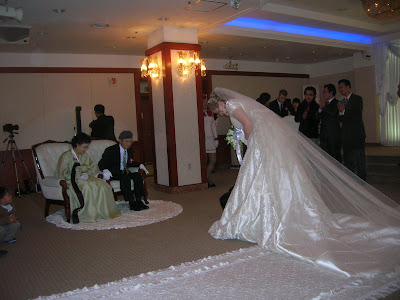Korean weddings are efficient. Getting married is not an everyday occurrence, but wedding halls in

As the guests arrive, they are greeted by the father of the bride and groom and they sign in and pay. Yes, pay. There are no wedding presents given (same with Chinese weddings as I found out in Singapore), rather you give a certain amount of money depending on how close you are to the person. This is a rare opportunity to assign a monetary value to your friendship, and could be the reason that so many people attend these weddings. $50 is considered the least you would give if you were simply a mere acquaintance. Good friends run in the hundreds, and best friends may require pawning a non-vital major organ like the heart or skin (yes it IS an organ, didn’t you take 4th grade science?). When you sign in, your name is written next to the amount you gave, recording your friendship rating for all posterity. At this time you receive your meal ticket (after all, it’s the second reason you came besides forced tributes). Jeong apologized on behalf of all Koreans, being that the majority of people that come to your wedding will obtain their ticket and proceed directly to the floor above to get their dinner, then leave. But don’t worry, you know they really do care as long as they gave more than a paltry $50.
Everybody who desires to see the ceremony waits outside the actual wedding chapel as the previous ceremony is finishing. As they file out, you file in (hey the seats are still warm!). Take your seat quickly because before you know it “Here’s Comes the Bride” is pumping out of the speaker system and the procession has begun! Koreans don’t use bridesmaids or groomsmen so they were entirely without a clue as to what to do with these six extra people standing at the altar. The ceremony proceeds pretty similarly to its western counterpart except the fact that the Koreans gave a pleased gasp of surprise as they kissed at the end (a normally absent bit that Laura insisted upon (my family are real kissers)). 


You’ll have as many children as the fruit you catch. The Na’s (the new couple) caught 9. They now have no choice but to have 9 children, it’s tradition and it’s never wrong.
Finally we went to the mess hall once everybody had already eaten and left (no, I’m serious). It seems that you can really have any type of event you would like at these event halls, check out the banner.

Laura is wearing a traditional bride’s hambok, characterized by the rainbow sleeves. This is not to be confused with the rainbow affiliated with gays, since they actually can’t get married. This is a serious conflict, which accounts for the sparseness of gays in
An interesting sidenote (and much more serious than my gay comment above) is how uncommon it is to see a mixed couple in


3 comments:
Very interesting post.Really wasn't aware of the Korean wedding traditions.Thanx a lot for enlightening me. Some traditions like giving money as a wedding present is some thing much more practical and well appreciated but the custom of throwing fruit to determine the number of children did not make much sense to me though.Please do not take any offence, this is just what I felt about the whole thing. All our traditions have a lot of customs which we like or dislike but still we do respect it.Thanks a lot once again.
I write about weddings too, so love to read a lot on it.Do peep into my wedding blog too and lemme know how you like it!! Cheers!!
When you say the parents throw the fruits at the bride and then the groom catches it with this apron. How many fruits does the parent usually throw?
They toss a couple of handfuls, I think about 8 or so fruit. At least, that's what we saw.
Post a Comment